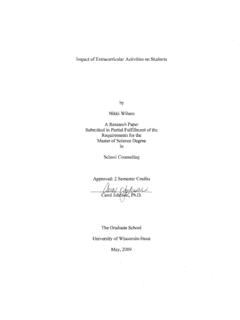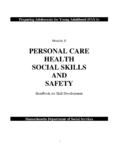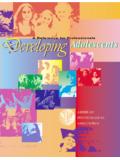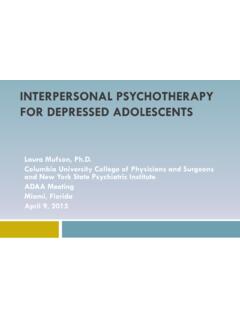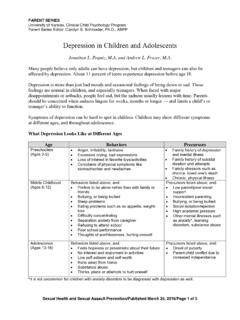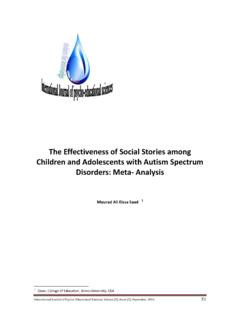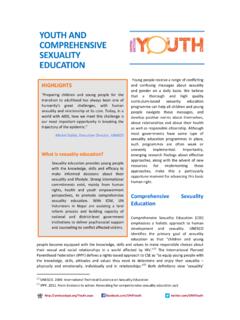Transcription of World report on vision - WHO | World Health Organization
1 AWorld report on visionWorld report on visionWorld report on vision ISBN 978-92-4-151657-0 World Health Organization 2019 Some rights reserved. This work is available under the Creative Commons Attribution-NonCommercial-ShareAlike IGO licence (CC BY-NC-SA IGO; ). Under the terms of this licence, you may copy, redistribute and adapt the work for non-commercial purposes, provided the work is appropriately cited, as indicated below. In any use of this work, there should be no suggestion that WHO endorses any specific Organization , products or services. The use of the WHO logo is not permitted. If you adapt the work, then you must license your work under the same or equivalent Creative Commons licence.
2 If you create a translation of this work, you should add the following disclaimer along with the suggested citation: This translation was not created by the World Health Organization (WHO). WHO is not responsible for the content or accuracy of this translation. The original English edition shall be the binding and authentic edition . Any mediation relating to disputes arising under the licence shall be conducted in accordance with the mediation rules of the World Intellectual Property citation. World report on vision . Geneva: World Health Organization ; 2019. Licence: CC BY-NC-SA (CIP) data. CIP data are available at , rights and licensing.
3 To purchase WHO publications, see To submit requests for commercial use and queries on rights and licensing, see Third-party materials. If you wish to reuse material from this work that is attributed to a third party, such as tables, figures or images, it is your responsibility to determine whether permission is needed for that reuse and to obtain permission from the copyright holder. The risk of claims resulting from infringement of any third-party-owned component in the work rests solely with the disclaimers. The designations employed and the presentation of the material in this publication do not imply the expression of any opinion whatsoever on the part of WHO concerning the legal status of any country, territory, city or area or of its authorities, or concerning the delimitation of its frontiers or boundaries.
4 Dotted and dashed lines on maps represent approximate border lines for which there may not yet be full mention of specific companies or of certain manufacturers products does not imply that they are endorsed or recommended by WHO in preference to others of a similar nature that are not mentioned. Errors and omissions excepted, the names of proprietary products are distinguished by initial capital reasonable precautions have been taken by WHO to verify the information contained in this publication. However, the published material is being distributed without warranty of any kind, either expressed or implied. The responsibility for the interpretation and use of the material lies with the reader.
5 In no event shall WHO be liable for damages arising from its in SwitzerlandiiiContentsForeword vAcknowledgements viiAbbreviations ixExecutive summary xIntroduction xivChapter 1 vision , eye conditions and vision impairment 1 vision 3 Eye conditions 4 vision impairment 10 Chapter 2 Global magnitude: eye conditions and vision impairment 22 Global magnitude: eye conditions 24 Global magnitude: vision impairment 26 The costs of addressing the coverage gap 28 Distribution 30 Access and barriers to eye care services 36 Projections of eye conditions 41 Chapter 3 Addressing eye conditions and vision impairment 49 Strategies to address eye care needs 51 Health promotion 51 Prevention 53 Treatment 55 Rehabilitation 58 Chapter 4 Successes and remaining challenges in eye care 71 Global concerted action 73 Challenges moving forward 77 Chapter 5 Advancing universal Health coverage through eye care 97 Universal Health coverage 99 Quality eye care services according to
6 Population needs 101 Ensuring that costs are not a barrier to eye care 108ivChapter 6 Integrated people-centred eye care 115 Integrated people-centred eye care 117 Empowering and engaging people and communities 118 Reorienting the model of care 122 Coordinating services within and across sectors 125 Creating an enabling environment 129 Recommendations 146 Annexes 153 Annex I: Regional comparisons of the numbers of people with selected eye conditions 154 Annex Ii: List of countries included in the regional comparisons of selected eye conditions and vision impairment presented in Chapter 2 and Annex 1 of this report 156vForewordIn a World built on the ability to see, vision , the most dominant of our senses, is vital at every turn of our lives.
7 The newborn depends on vision to recognize and bond with its mother; the toddler, to master balance and learn to walk; the schoolboy, to walk to school, read and learn; the young woman to participate in the workforce; and the older woman, to maintain her independence. Yet, as this report shows, eye conditions and vision impairment are widespread, and far too often they still go untreated. Globally, at least billion people have a vision impairment, and of these, at least 1 billion people have a vision impairment that could have been prevented or is yet to be addressed. As usual, this burden is not borne equally. It weighs more heavily on low- and middle-income countries, on older people, and on rural communities.
8 Most worrying is that projections show that global demand for eye care is set to surge in the coming years due to population growth, ageing, and changes in , we have no choice but to take on this challenge. It is time to make sure that as many people as possible in all countries can see as well as current Health technologies and Health systems allow. But it is important to recognize and build on the many successes in eye care of the last decades. One such success has been the WHO-endorsed SAFE strategy for trachoma elimination. Implemented in over 30 countries, it has so far resulted in eight countries eliminating trachoma as a public Health problem.
9 Other examples include public private partnerships to provide spectacles in Pakistan, Sri Lanka, and South Africa. The World report on vision sets out concrete proposals to address challenges in eye care. The key proposal is to make integrated people-centred eye care, embedded in Health systems and based on strong primary Health care, the care model of choice and scale it up widely. People who need eye care must be able to receive high-quality interventions without suffering financial hardship. Including eye care in national Health plans and essential packages of care is an important part of every country s journey towards universal Health is committed to working with countries to improve the delivery of eye care, in particular through primary Health care; to improving Health information systems for eye care; and to strengthening the eye care workforce three enabling factors for implementing integrated people-centred eye care.
10 ViBut WHO cannot achieve this task alone. International organizations, donors, and the public and private sectors must work together to provide the long-term investment and management capacity to scale up integrated people-centred eye care. Our hope is that, building on past efforts, we can successfully take on this challenge and help countries prevent eye conditions and vision impairment more effectively and provide quality eye care services according to the needs of their populations. Dr Tedros Adhanom Ghebreyesus Director-General World Health OrganizationviiAcknowledgementsThe World Health Organization (WHO) would like to thank the more than 200 report advisors and editors, peer reviewers, WHO staff and other contributors for their support and guidance.











